Impact of Thermal Processing on the Structure, Antioxidant Properties and Hypoglycemic Activities of Sweet Potato Polysaccharides
Abstract
:1. Introduction
2. Materials and Methods
2.1. Materials and Chemicals
2.2. Preparation of Sweet Potato Powder
2.3. Extraction of Sweet Potato Crude Polysaccharide
2.4. Determination of Monosaccharide Composition
2.4.1. Sample Preparation and Extraction
2.4.2. GC-MS Analysis
2.5. Total Sugar, Total Protein, and Total Glucuronide Content
2.6. Fourier Transformation Infrared (FT-IR) Spectroscopy Analysis
2.7. Scanning Electron Microscopy (SEM) Analysis
2.8. Determination of Zeta Potential and Particle Size
2.9. Antioxidant Activity Assay
2.9.1. DPPH Scavenging Assay
2.9.2. Hydroxyl Radical Scavenging Assay
2.9.3. Reducing Power Assay
2.10. In Vitro Hypoglycemic Activity Assay
2.10.1. Measurement of α-Amylase Inhibitory Activity
2.10.2. Measurement of α-Glucosidase Inhibitory Activity
2.11. Statistical Analysis
3. Results and Discussion
3.1. Polysaccharide Extraction
3.2. Physicochemical Properties of Polysaccharides
3.2.1. Measurement of Monosaccharide Composition
3.2.2. Determination of Total Sugar, Total Protein, and Total Glucuronic Acid Content
3.2.3. Analysis of the Fourier Transform-Infrared Spectroscopy (FT-IR)
3.2.4. Scanning Electron Microscopy (SEM)
3.2.5. Measurements of Zeta Potential Value and Particle Size
3.3. Antioxidant Activity Assay
3.4. In Vitro Hypoglycemic Activity Assay
4. Conclusions
Author Contributions
Funding
Data Availability Statement
Acknowledgments
Conflicts of Interest
References
- Liu, C.; Miao, Y.; Zhao, J.; Yang, S.; Cheng, S.; Zhou, W.; Guo, W.; Li, A. In vitro simulated digestion of different heat treatments sweet potato polysaccharides and effects on human intestinal flora. Food Chem. 2024, 463, 141190. [Google Scholar] [CrossRef] [PubMed]
- Yang, W.; Lu, X.; Zhang, Y.; Qiao, Y. Effect of cooking methods on the health-promoting compounds, antioxidant activity and nitrate of tatsoi (Brassica rapa L. ssp. narinosa). J. Food Process. Preserv. 2019, 43, e14008. [Google Scholar] [CrossRef]
- Zhang, J.J.; Ji, R.; Hu, Y.Q.; Chen, J.C.; Ye, X.Q. Effect of three cooking methods on nutrient components and antioxidant capacities of bamboo shoot (Phyllostachys praecox CD Chu et CS Chao). J. Zhejiang Univ. Sci. B 2011, 12, 752–759. [Google Scholar] [CrossRef] [PubMed]
- Rodrigues, A.S.; Pérez-Gregorio, M.R.; García-Falcón, M.S.; Simal-Gándara, J. Effect of curing and cooking on flavonols and anthocyanins in traditional varieties of onion bulbs. Food Res. Int. 2009, 42, 1331–1336. [Google Scholar] [CrossRef]
- Cai, J.T.; Cao, W.H.; Chen, Z.Q. Effects of different thermal processing on the structure and digestive characteristics of protein and polysaccharide of Chlamys nobilis. Food Ferment. Ind. 2022, 48, 52–60. [Google Scholar]
- Shekhar, S.; Mishra, D.; Buragohain, A.K.; Chakraborty, S.; Chakraborty, N. Comparative analysis of phytochemicals and nutrient availability in two contrasting cultivars of sweet potato (Ipomoea batatas L.). Food Chem. 2015, 173, 957–965. [Google Scholar] [CrossRef] [PubMed]
- Lee, J.J.; Park, K.W.; Kwak, Y.S.; Ahn, J.Y.; Jung, Y.H.; Lee, B.H.; Jeong, J.C.; Lee, H.S.; Kwak, S.S. Comparative proteomic study between tuberous roots of light orange and purple-fleshed sweetpotato cultivars. Plant Sci. 2012, 193, 120–129. [Google Scholar] [CrossRef]
- Parveen, A.; Choi, S.; Kang, J.H.; Oh, S.H.; Kim, S.Y. Trifostigmanoside I, an active compound from sweet potato, restores the activity of MUC2 and protects the tight junctions through PKCα/β to maintain intestinal barrier function. Int. J. Mol. Sci. 2020, 22, 291. [Google Scholar] [CrossRef]
- Shandilya, U.K.; Sharma, A. Functional foods and their benefits: An overview. J. Nutr. Health Food Eng. 2017, 7, 353–356. [Google Scholar] [CrossRef]
- Facchini, J.M.; Alves, E.P.; Aguilera, C.; Gern, R.M.M.; Silveira, M.L.L.; Wisbeck, E.; Furlan, S.A. Antitumor activity of Pleurotus ostreatus polysaccharide fractions on Ehrlich tumor and Sarcoma 180. Int. J. Biol. Macromol. 2014, 68, 72–77. [Google Scholar] [CrossRef]
- Ghavi, P.P. The extraction process optimization of antioxidant polysaccharides from Marshmallow (Althaea officinalis L.) roots. Int. J. Biol. Macromol. 2015, 75, 51–57. [Google Scholar] [CrossRef] [PubMed]
- Nguyen, H.C.; Chen, C.C.; Lin, K.H.; Chao, P.Y.; Lin, H.H.; Huang, M.Y. Bioactive compounds, antioxidants, and health benefits of sweet potato leaves. Molecules 2021, 26, 1820. [Google Scholar] [CrossRef] [PubMed]
- Gomez-Gonzalez, S.; Ruiz-Jimenez, J.; Priego-Capote, F.; Luque de Castro, M.D. Qualitative and quantitative sugar profiling in olive fruits, leaves, and stems by gas chromatography-tandem mass spectrometry (GC-MS/MS) after ultrasound-assisted leaching. J. Agric. Food Chem. 2010, 58, 12292–12299. [Google Scholar] [CrossRef] [PubMed]
- Zheng, H.; Zhang, Q.; Quan, J.; Zheng, Q.; Xi, W. Determination of sugars, organic acids, aroma components, and carotenoids in grapefruit pulps. Food Chem. 2016, 205, 112–121. [Google Scholar] [CrossRef]
- Sun, S.; Wang, H.; Xie, J.; Su, Y. Simultaneous determination of rhamnose, xylitol, arabitol, fructose, glucose, inositol, sucrose, maltose in jujube (Zizyphus jujube Mill.) extract: Comparison of HPLC–ELSD, LC–ESI–MS/MS and GC–MS. Chem. Cent. J. 2016, 10, 1–9. [Google Scholar] [CrossRef]
- Cuesta, G.; Suarez, N.; Bessio, M.I.; Ferreira, F.; Massaldi, H. Quantitative determination of pneumococcal capsular polysaccharide serotype 14 using a modification of phenol–sulfuric acid method. J. Microbiol. Methods 2003, 52, 69–73. [Google Scholar] [CrossRef]
- Gao, X.F.; Wen, X.J. Determination of protein in lipid samples by the ethanol precipitation BCA method. Her. Med. 2010, 29, 1630–1633. [Google Scholar]
- Chen, C.; Zhang, B.; Fu, X.; You, L.J.; Abbasi, A.M.; Liu, R.H. The digestibility of mulberry fruit polysaccharides and its impact on lipolysis under simulated saliva, gastric and intestinal conditions. Food Hydrocoll. 2016, 58, 171–178. [Google Scholar] [CrossRef]
- Cumby, N.; Zhong, Y.; Naczk, M.; Shahidi, F. Antioxidant activity and water-holding capacity of canola protein hydrolysates. Food Chem. 2008, 109, 144–148. [Google Scholar] [CrossRef]
- Xu, J.; Xu, L.L.; Zhou, Q.W.; Hao, S.X.; Zhou, T.; Xie, H.J. Isolation, purification, and antioxidant activities of degraded polysaccharides from Enteromorpha prolifera. Int. J. Biol. Macromol. 2015, 81, 1026–1030. [Google Scholar] [CrossRef]
- Zhu, K.; Zhou, H.; Qian, H. Antioxidant and free radical-scavenging activities of wheat germ protein hydrolysates (WGPH) prepared with alcalase. Process Biochem. 2006, 41, 1296–1302. [Google Scholar] [CrossRef]
- Chen, S.; Chen, H.; Tian, J.; Wang, Y.; Xing, L.; Wang, J. Chemical modification, antioxidant and α-amylase inhibitory activities of corn silk polysaccharides. Carbohydr. Polym. 2013, 98, 428–437. [Google Scholar] [CrossRef] [PubMed]
- Li, S.; Shah, N.P. Antioxidant and antibacterial activities of sulphated polysaccharides from Pleurotus eryngii and Streptococcus thermophilus ASCC 1275. Food Chem. 2014, 165, 262–270. [Google Scholar] [CrossRef] [PubMed]
- Wu, Q.; Qu, H.; Jia, J.; Kuang, C.; Wen, Y.; Yan, H.; Gui, Z. Characterization, antioxidant and antitumor activities of polysaccharides from purple sweet potato. Carbohydr. Polym. 2015, 132, 31–40. [Google Scholar] [CrossRef] [PubMed]
- Zhou, S.; Huang, G.; Huang, H. Extraction, derivatization, and antioxidant activities of onion polysaccharide. Food Chem. 2022, 388, 133000. [Google Scholar] [CrossRef]
- Li, C.; Feng, Y.; Wang, C. Extraction Optimization and Structure of Water-Soluble Polysaccharides from Purple Sweet Potato. Food Res. Dev. 2022, 43, 125–133. [Google Scholar] [CrossRef]
- Cao, Z.L. Isolation and Purification of Polysaccharides from Artemisia Annua L. Hypoglycemic Activity and Their Digestive Enzymolysis in Vitro; South China University of Technology: Guangzhou, China, 2021. [Google Scholar]
- Yang, W.; Huang, G. Extraction, structural characterization, and physicochemical properties of polysaccharide from purple sweet potato. Chem. Biol. Drug Des. 2021, 98, 979–985. [Google Scholar] [CrossRef]
- Chi, Y.; Li, Y.; Zhang, G.; Gao, Y.; Ye, H.; Gao, J.; Wang, P. Effect of extraction techniques on properties of polysaccharides from Enteromorpha prolifera and their applicability in iron chelation. Carbohydr. Polym. 2018, 181, 616–623. [Google Scholar] [CrossRef] [PubMed]
- Sun, Y.; Wang, H.; Guo, G.; Pu, Y.; Yan, B. The isolation and antioxidant activity of polysaccharides from the marine microalgae Isochrysis galbana. Carbohydr. Polym. 2014, 113, 22–31. [Google Scholar] [CrossRef]
- Shao, P.; Chen, X.; Sun, P. Chemical characterization, antioxidant and antitumor activity of sulfated polysaccharide from Sargassum horneri. Carbohydr. Polym. 2014, 105, 260–269. [Google Scholar] [CrossRef]
- Li, S.; Shah, N.P. Characterization, antioxidative and bifidogenic effects of polysaccharides from Pleurotus eryngii after heat treatments. Food Chem. 2016, 197, 240–249. [Google Scholar] [CrossRef] [PubMed]
- Dong, J.L.; Yang, M.; Zhu, Y.Y.; Shen, R.L.; Zhang, K.Y. Comparative study of thermal processing on the physicochemical properties and prebiotic effects of the oat β-glucan by in vitro human fecal microbiota fermentation. Food Res. Int. 2020, 138, 109818. [Google Scholar] [CrossRef] [PubMed]
- Cheng, N.; Ren, N.; Gao, H.; Lei, X.; Zheng, J.; Cao, W. Antioxidant and hepatoprotective effects of Schisandra chinensis pollen extract on CCl4-induced acute liver damage in mice. Food Chem. Toxicol. 2013, 55, 234–240. [Google Scholar] [CrossRef] [PubMed]
- Zhong, S.; Zhou, S.; Wu, J.; Yu, Y.; Peng, J.; Fu, M.; Cheng, L.; Xu, Y. Structural Characterization, Antioxidant, and Prebiotic Activity of Wampee Polysaccharides; Food and Fermentation Industries: Beijing, China, 2024. [Google Scholar]
- Wang, Z.; Wang, C.; Su, T.; Zhang, J. ntioxidant and immunological activities of polysaccharides from Gentiana scabra Bunge roots. Carbohydr. Polym. 2014, 112, 114–118. [Google Scholar] [CrossRef]
- Lai, F.; Wen, Q.; Li, L.; Wu, H.; Li, X. Antioxidant activities of water-soluble polysaccharide extracted from mung bean (Vigna radiata L.) hull with ultrasonic assisted treatment. Carbohydr. Polym. 2010, 81, 323–329. [Google Scholar] [CrossRef]
- Zhang, J.; Ma, Z.; Zheng, L.; Zhai, G.; Wang, L.; Jia, M.; Jia, L. Purification and antioxidant activities of intracellular zinc polysaccharides from Pleurotus cornucopiae SS-03. Carbohydr. Polym. 2014, 111, 947–954. [Google Scholar] [CrossRef]
- Yuan, B.; Bu, W.; Dai, W.; Ju, X.; Wang, X. Isolation and Structural Characterization of an Antioxidant Polysaccharide from Purple Sweet Potato and Metabonomic Evaluation of Its Antioxidant Mechanism. Food Sci. 2022, 43, 69–78. [Google Scholar] [CrossRef]
- Chen, F.; Huang, G. Extraction and antioxidant activities of cushaw polysaccharide. Int. J. Biol. Macromol. 2018, 120, 1646–1649. [Google Scholar] [CrossRef] [PubMed]
- Hu, J.; Liu, Y.; Cheng, L.; Shi, R.; Qayum, A.; Bilawal, A.; Gantumur, M.; Hussain, M.; Jiang, Z.; Tian, B. Comparison in bioactivity and characteristics of Ginkgo biloba seed polysaccharides from four extract pathways. Int. J. Biol. Macromol. 2020, 159, 1156–1164. [Google Scholar] [CrossRef]

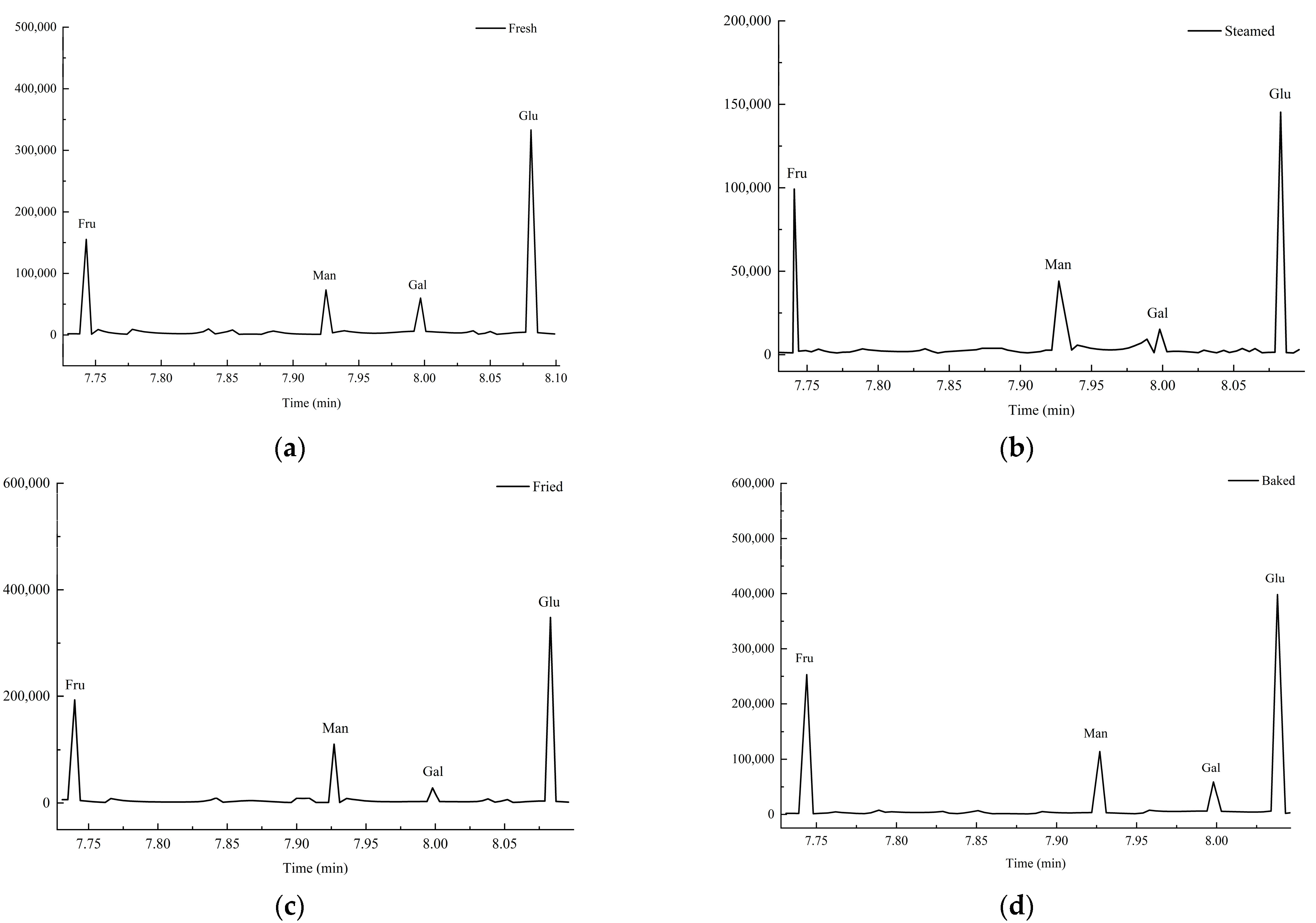
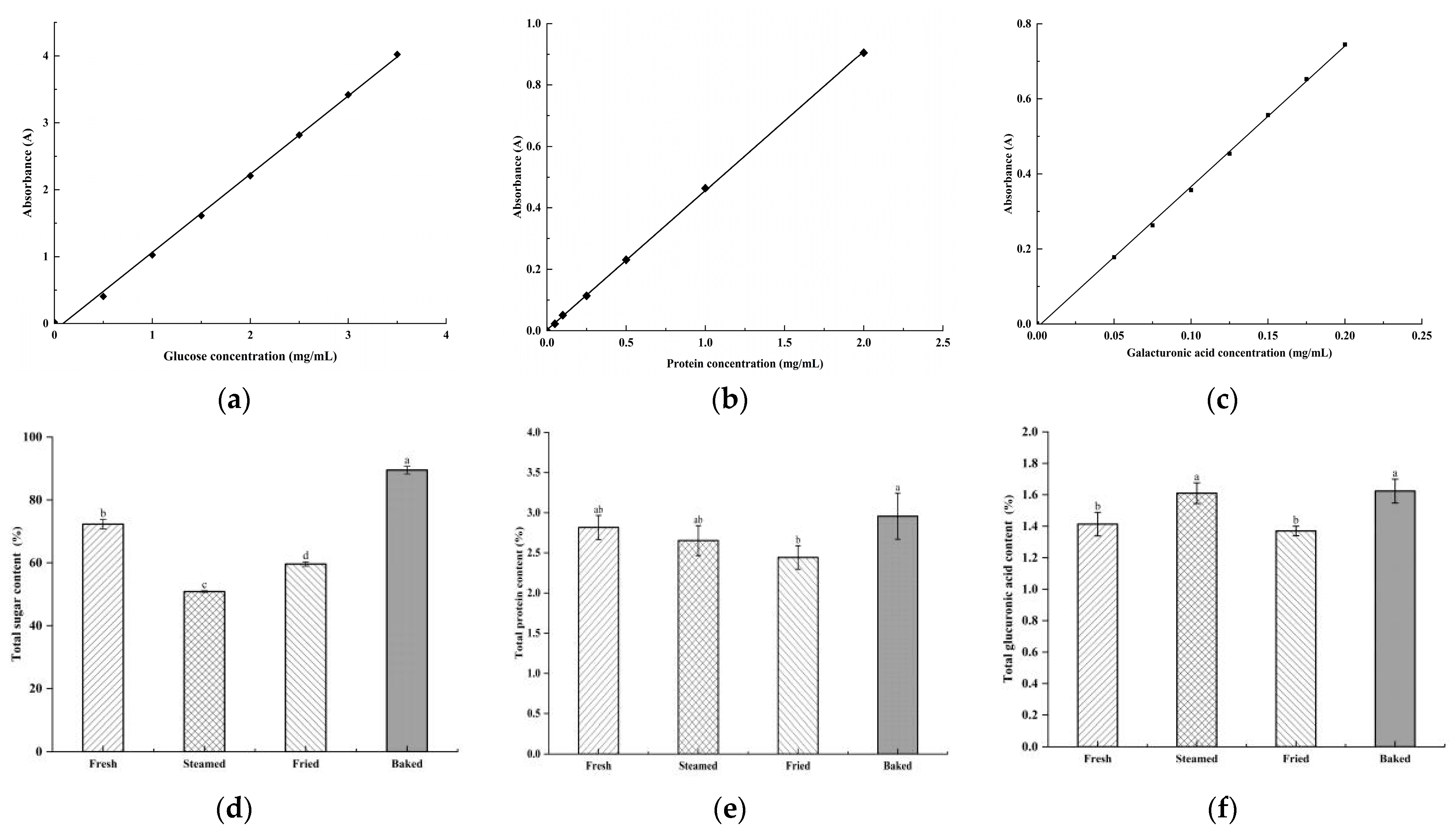
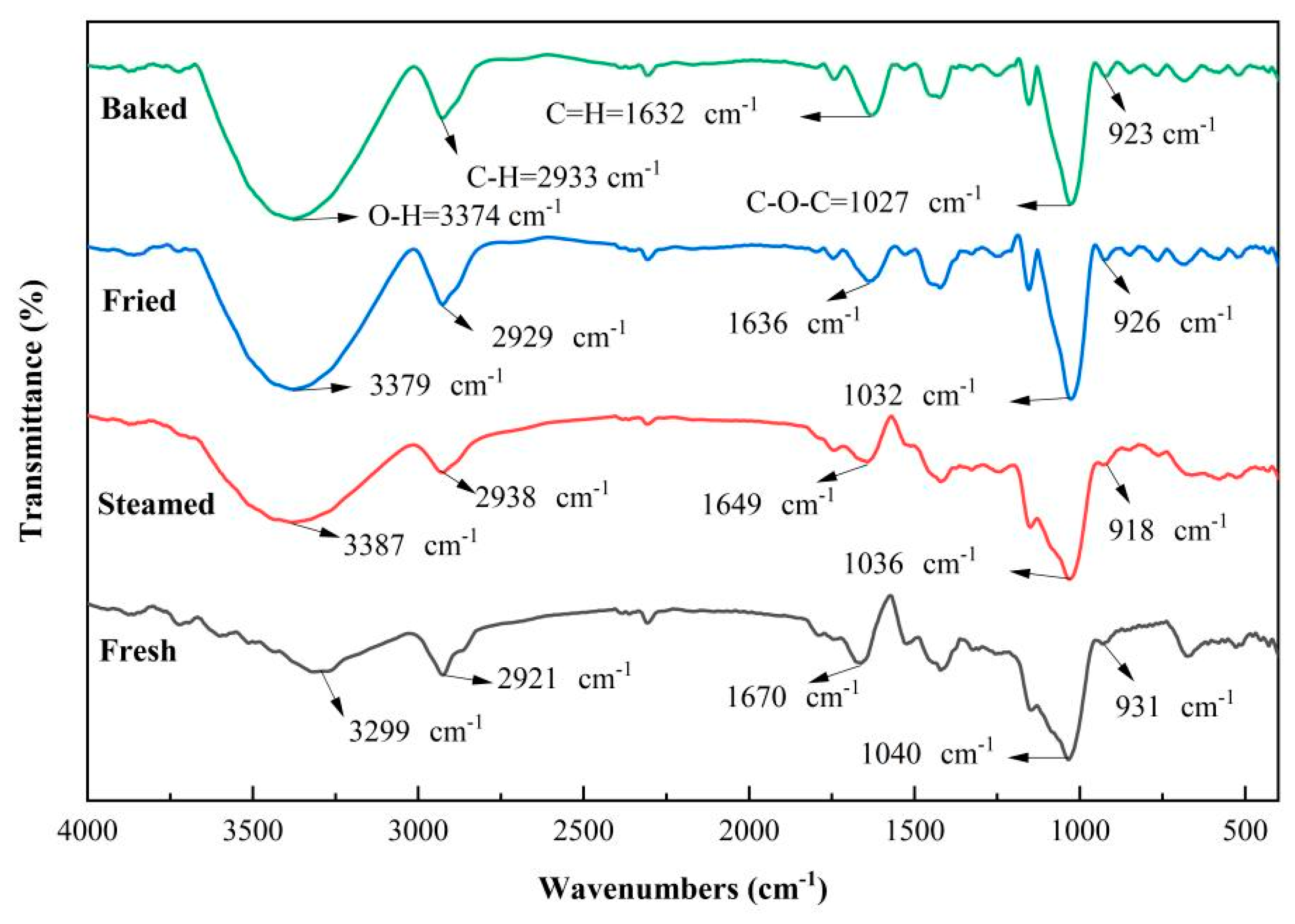
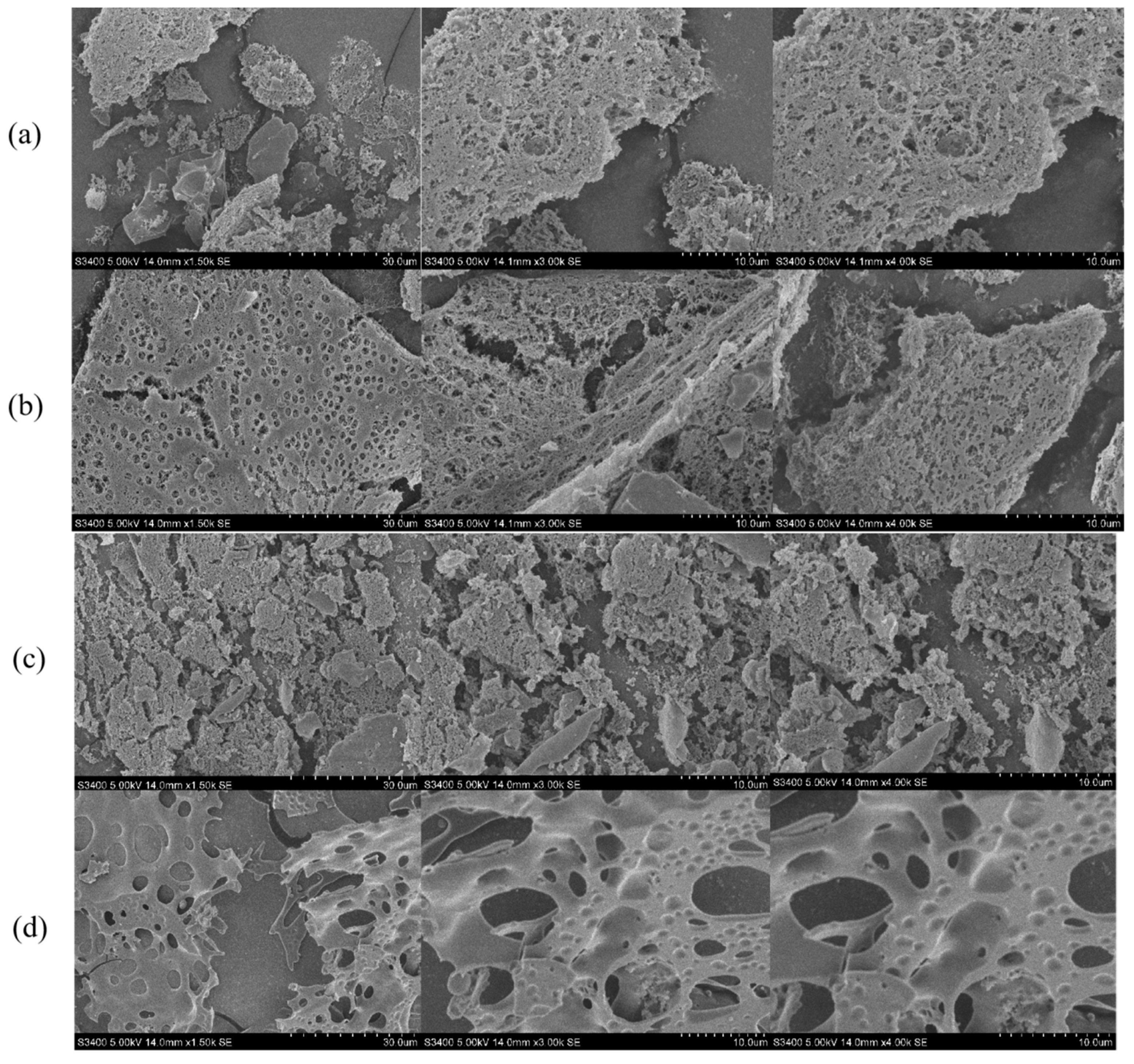

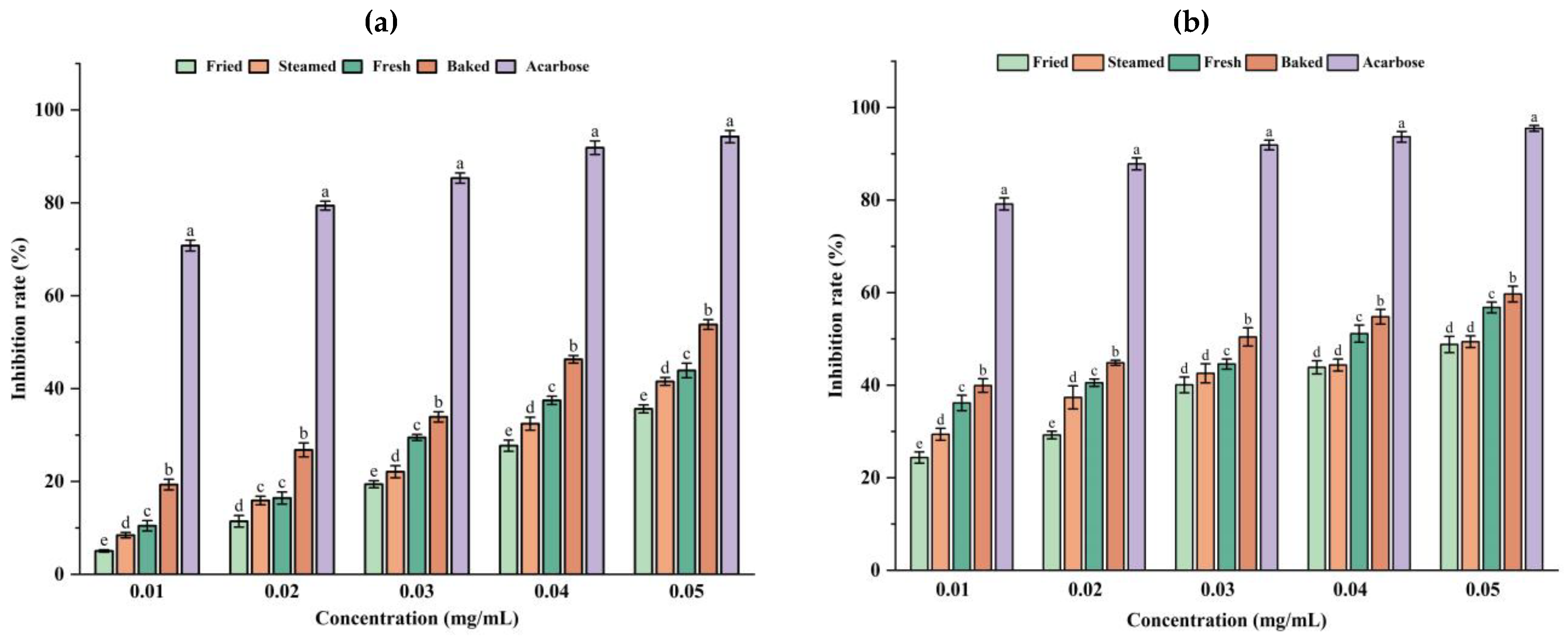
| Monosaccharide Composition | Gal | Man | Fru | Glu |
|---|---|---|---|---|
| Fresh | 1.0 | 1.6 | 52.1 | 82.3 |
| Steamed | 1.0 | 2.3 | 32.9 | 35.3 |
| Fried | 1.0 | 7.7 | 74.2 | 136.0 |
| Baked | 1.0 | 7.2 | 63.8 | 248.4 |
| Particle Size and Zeta-Values | Fresh | Steamed | Baked | Fried |
|---|---|---|---|---|
| particle size (nm) | 380.87 ± 3.59 d | 433.13 ± 14.52 c | 523.90 ± 11.63 b | 808.20 ± 32.34 a |
| Zeta-values (mV) | −33.14 ± 1.11 b | −34.42 ± 0.39 b | −30.48 ± 0.65 a | −30.29 ± 1.20 a |
Disclaimer/Publisher’s Note: The statements, opinions and data contained in all publications are solely those of the individual author(s) and contributor(s) and not of MDPI and/or the editor(s). MDPI and/or the editor(s) disclaim responsibility for any injury to people or property resulting from any ideas, methods, instructions or products referred to in the content. |
© 2024 by the authors. Licensee MDPI, Basel, Switzerland. This article is an open access article distributed under the terms and conditions of the Creative Commons Attribution (CC BY) license (https://creativecommons.org/licenses/by/4.0/).
Share and Cite
Liu, C.; Miao, Y.; Zhou, W.; Ma, Y.; Guo, W.; Li, A. Impact of Thermal Processing on the Structure, Antioxidant Properties and Hypoglycemic Activities of Sweet Potato Polysaccharides. Foods 2024, 13, 3082. https://doi.org/10.3390/foods13193082
Liu C, Miao Y, Zhou W, Ma Y, Guo W, Li A. Impact of Thermal Processing on the Structure, Antioxidant Properties and Hypoglycemic Activities of Sweet Potato Polysaccharides. Foods. 2024; 13(19):3082. https://doi.org/10.3390/foods13193082
Chicago/Turabian StyleLiu, Chuan, Yu Miao, Wenjia Zhou, Yiming Ma, Wenkui Guo, and Aili Li. 2024. "Impact of Thermal Processing on the Structure, Antioxidant Properties and Hypoglycemic Activities of Sweet Potato Polysaccharides" Foods 13, no. 19: 3082. https://doi.org/10.3390/foods13193082





